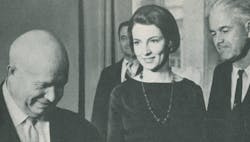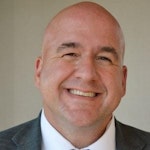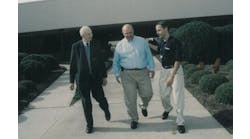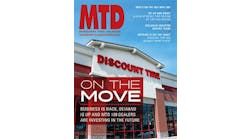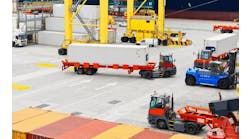MTD History: Tiremaker Exec's Adventure Behind the Iron Curtain
The recent passing of Sean Connery - the coolest James Bond - put me in a nostalgic mood for old spy movies and books.
While combing through the MTD library, I came across a tale that could have been penned by Bond creator Ian Fleming, if he worked for this publication during the 1960s.
It involves a jet-setting westerner, a Cold War autocrat, a shadowy figure and a secret meeting inside the Kremlin - not a bad “plot,” by any stretch!
What really happened when Russell DeYoung, then-president of Goodyear Tire & Rubber Co., met with Nikita Khrushchev, the premier of the Soviet Union, in November 1963 was decidedly less cinematic.
But their “summit” had some unusual - and colorful - moments. (DeYoung chronicled his experience in an article published in the January 1964 issue of MTD.)
Khrushchev had invited DeYoung and several other U.S. businessmen to meet with him in Moscow, with the stated goal of “giving our group a better understanding of the world situation,” wrote DeYoung. (Representatives from Time magazine were along for the ride, as well.)
It quickly became apparent that Khrushchev, who would be replaced as the USSR’s top “executive” just one year later, had other things in mind.
Right after the American delegates arrived in Moscow, DeYoung was approached by a “shadow” who had been assigned to him. The man cut right to the chase.
“First, Mr. DeYoung, what kind of plants do you have for sale and how many of them do you have for sale?” he asked. (By “plants,” he wasn’t referring to the potted variety.)
“To impress me with his authority and, I guess, good faith, he whipped out what looked like a checkbook and announced - in excellent English - that he had plenty of money and was ready to pay for his purchases in cash,” wrote DeYoung, who immediately replied that Goodyear’s factories were not for sale.
Undaunted, the man shot back, “I’ve had commercial dealings with Mitsui and Mitsubishi of Japan, Pirelli of Italy, Courtaulds of England, Krupp of Germany and others. Why shouldn’t you sell to us?”
DeYoung held his ground and the man with the book full of blank checks faded back into the woodwork.
The next day, after a quick sightseeing tour of Moscow, DeYoung and his peers were escorted into the Kremlin, where they met Khrushchev.
To get there, they walked down a hall filled with “the biggest array of motion picture and television cameras I’ve ever seen assembled anywhere.”
Moments later, the Soviet boss quipped, “You think the communists are in control here, but you can see that the photographers are actually in control!”
After exchanging pleasantries, he told the delegation that the Soviets “were interested in building a new life, that they wanted to achieve victory to beat us, the United States - not physically, but through superior achievements in production,” wrote DeYoung.
The premier then “went to great lengths” to explain what he meant by the infamous “we will bury you” statement he made nearly a decade earlier.
“He explained that what he really meant was that our system in the U.S. had so many weaknesses it would fail,” DeYoung wrote. “When this happened, he said, the American workers would turn to communism. Over and over, he repeated that he wanted to prepare us to become communists.”
Khrushchev proceeded to tell DeYoung and his colleagues that “a certain amount of trade between the Soviet Union and the U.S. would be good for both countries,” DeYoung wrote.
“At this point, he turned to the minister of foreign trade, who was sitting beside him, thrust his finger at him and said, ‘But don’t let the Americans cheat you!’”
During the three-hour-long meeting, Khrushchev meandered through a wide range of geopolitical topics.
He discussed the possible reunification of Germany, which wouldn’t take place until 1990 (“The premier said this could be accomplished whenever the west Germans turned communist,” wrote DeYoung); tensions in Cuba (“Bluntly, he told us that any attack on Cuba could only lead to war.”); and the arms race (“He said it would take only 30 minutes for his ballistic missiles to cross the globe into our lands and that he is quite aware that ours could hit his lands in a similar time.”)
The next day, Khrushchev’s guests were treated to an old-fashioned Soviet military parade.
“We later learned that a large banner flying over our seats proclaimed, ‘Forward to the victory of communism.’ I’m sure this was not intentional,” DeYoung wryly commented.
That night, they attended a reception (“among the guests were Russian cosmonauts”) during which Khrushchev “delivered a series of toasts and speeches, both of which everybody lost count of.”
No word if caviar was on the menu!
While in Moscow, DeYoung found some time to examine a number of Soviet-built tires. “I saw copies of tread designs we were making in the 1930’s,” he observed.
He also added that “the Russians have acquired their tire know-how from a consortium of five British firms. It should be made clear, however, that none of the British tire companies have any financial or operating interest in Soviet tire plants.”
As for that pesky government “shadow” who wanted to buy some tire factories?
He reemerged right before DeYoung and his colleagues boarded their plane back to America.
“Finally convinced that he would be unable to buy one or more of our plants, he sidled up to me and suggested that perhaps we could engage in an ‘exchange’ of industrial know-how,” wrote DeYoung. “I allowed the matter to drop.”
“From Russia with Love” this wasn’t!
But what an interesting story, nevertheless!
